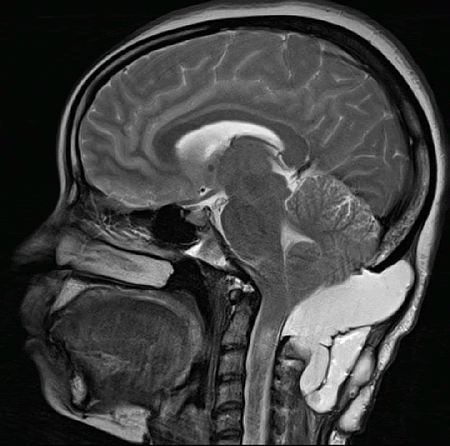ICEECE2012 Poster Presentations Pituitary Clinical (183 abstracts)
A difficult case of hyponatraemia in a neurosurgical patient
F Wernig , A Kaura , K Wynne , R Nair & K Meeran
Imperial College Healthcare NHS Trust, London, UK.
A 40-year-old female presented with a 6 week history of right-sided headaches and nausea. She was found to have an Arnold-Chiari malformation and an unusual C3 syrinx on MRI brain scanning. She underwent a foramen magnum decompression and C1 laminectomy. Three weeks later, she was admitted with headaches, nausea and vomiting, and blurring of her vision on left lateral gaze. Whilst in the emergency unit, the patient had a tonic-clonic seizure.
Following the seizure, she was noted to have a left 6th nerve palsy. She was hyponatraemic (119 mmol/l) with a blood osmolality of 253 mOsm/kg, urine osmolality of 640 mOsm/kg (specific gravity 1.030) and urinary sodium concentration of 97 mmol/l. Brain imaging demonstrated a large pseudomeningocele which had not been present on previous scans.
Administration of intravenous saline following the seizure further exacerbated her hyponatraemia (114 mmol/l). She was reviewed by the endocrinologists and a diagnosis of syndrome of inappropriate ADH secretion (SIADH) was made; strict fluid restriction maintained her serum sodium level at 119 mmol/l. Her urine osmolality remained inappropriately high (531 mOsmol/kg). Five days into her admission placement of a ventriculo-peritoneal shunt resulted in volume reduction of the pseudomeningocele. Following sugery, she began to pass large amounts of urine and her urine specific gravity fell to 1.005 within 12 h. Her sodium level gradually improved back towards the reference range (139 mmol/l) over the following four days. Both her headache and 6th nerve palsy resolved.
Hyponatraemia is the most common electrolyte disorder in neurosurgical patients. Here we describe a difficult case of hyponatraemia due to SIADH. Risks and benefits of administering hypertonic saline or Tolvaptan had to be weighed against the possibility of further hyponatraemic seizures. Early diagnosis, strict fluid restriction and concerted management by a multidisciplinary team were crucial for a beneficial outcome.

Pseudo-meningocele at the site of the Foramen Magnum decompression prior to supratentorial VP shunt placement.
Declaration of interest: The authors declare that there is no conflict of interest that could be perceived as prejudicing the impartiality of the research project.
Funding: This research did not receive any specific grant from any funding agency in the public, commercial or not-for-profit sector.
 }
}



